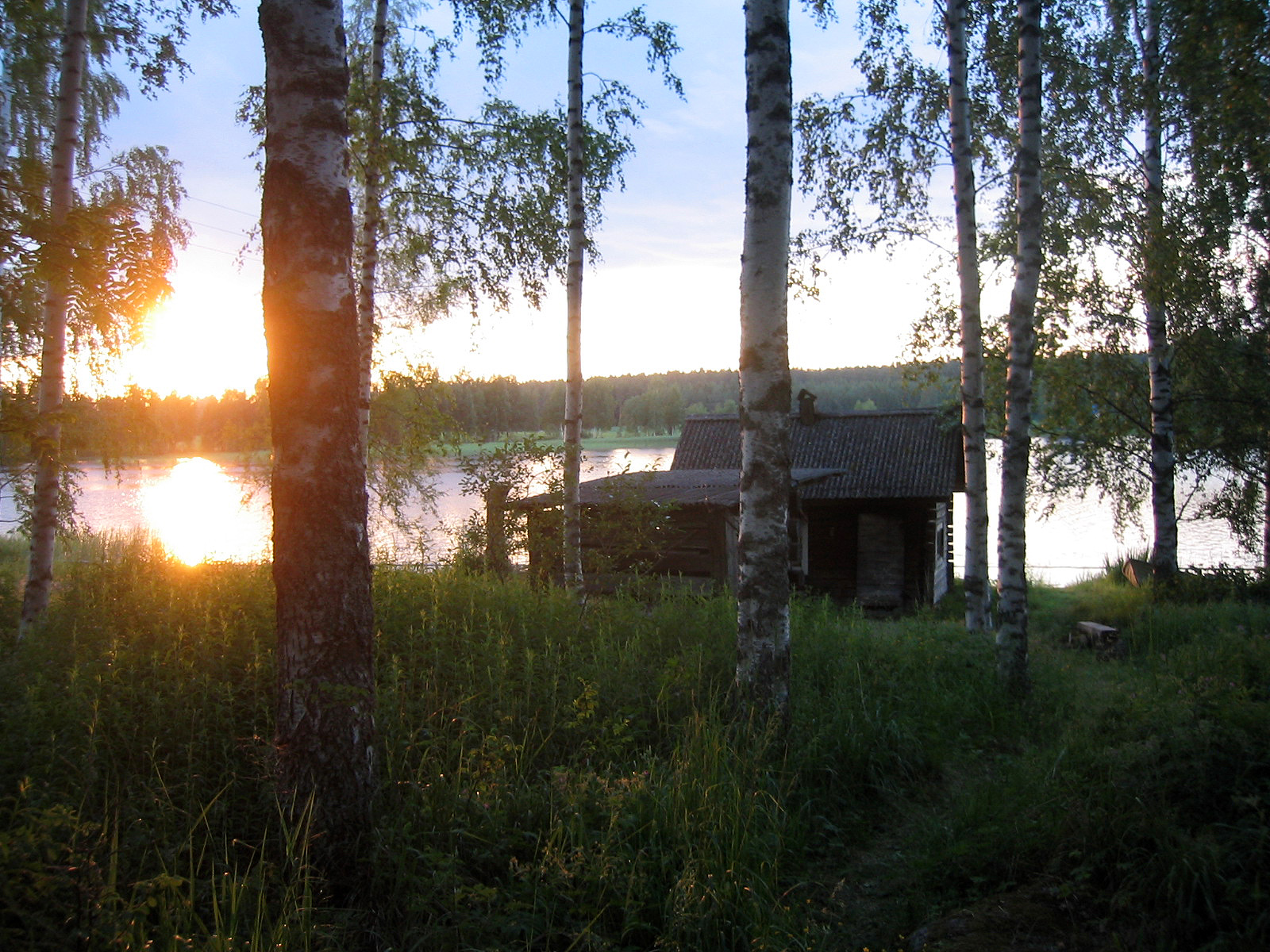
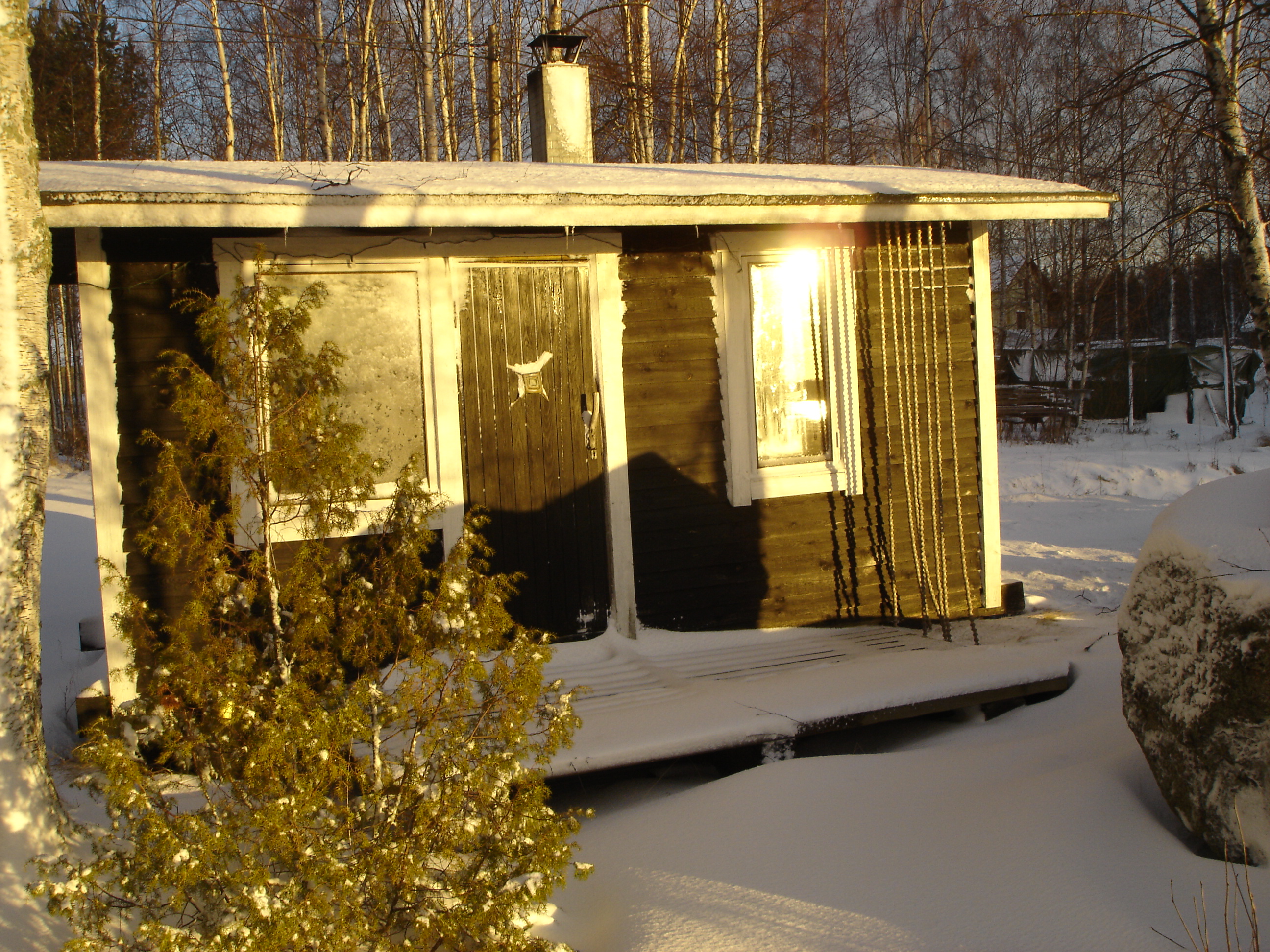
A Finnish wood-heated sauna in Korpilahti, Center Finland

A sauna is a small room or house designed as a place to experience dry or wet heat sessions, or an establishment with one or more of these and auxiliary facilities.
A sauna session can be a social affair in which the participants disrobe and sit or recline in temperatures typically between 70 °C (158 °F) and 110 °C (230 °F). This induces relaxation and promotes sweating.
Saunas can be divided into two basic styles: conventional saunas that warm the air or infrared saunas that warm objects. Infrared saunas may use various materials in their heating area such as charcoal, active carbon fibers, and other materials.
The word sauna is an ancient Finnish word referring to the traditional Finnish bath as well as to the bathhouse itself. The proto-Finnic reconstruction is *savńa. In Baltic-Finnish, sauna does not necessarily mean a building or space built for bathing. It can also mean a small cabin or cottage, such as a cabin for a fisherman.
The oldest known saunas were pits dug in a slope in the ground and primarily used as dwellings in winter. The sauna featured a fireplace where stones were heated to a high temperature. Water was thrown over the hot stones to produce steam and to give a sensation of increased heat. This would raise the apparent temperature so high that people could take off their clothes. The first Finnish saunas are what nowadays are called savusaunas, or smoke saunas. These differed from present-day saunas in that they were heated by heating a pile of rocks called kiuas by burning large amounts of wood about 6 to 8 hours, and then letting the smoke out before enjoying the löyly, or sauna heat. A properly heated "savusauna" gives heat up to 12 hours. These are still used in present-day Finland by some enthusiasts, but usually only on special occasions such as Christmas, New Year's, Easter, and juhannus.
As a result of the industrial revolution, the sauna evolved to use a metal woodstove, or kiuas, with a chimney. Air temperatures averaged around 70–80 degrees Celsius (160–180 degrees Fahrenheit) but sometimes exceeded 90 °C (200 °F) in a traditional Finnish sauna. Steam vapor, also called löyly, was created by splashing water on the heated rocks.
The steam and high heat caused bathers to perspire. The Finns also used a vihta (Western dialect, or vasta in Eastern dialect), which is a bundle of birch twigs with fresh leaves, to gently slap the skin and create further stimulation of the pores and cells.
The Finns also used the sauna as a place to cleanse the mind, rejuvenate and refresh the spirit, and prepare the dead for burial. The sauna was (and still is) an important part of daily life, and families bathed together in the home sauna. Because the sauna was often the cleanest structure and had water readily available, Finnish women also gave birth in the sauna.
Although the culture of sauna nowadays is more or less related to Finnish culture, it is important to note that the evolution of sauna has happened around the same time both in Finland and the Baltic countries sharing the same meaning and importance of sauna in daily life. The same sauna culture is shared in both places still to this day.
When the Finns migrated to other areas of the globe they brought their sauna designs and traditions with them, introducing other cultures to the enjoyment and health benefits of sauna. This led to further evolution of the sauna, including the electric sauna stove, which was introduced on 11 May 1951 by Johannes Säubel in Helsinki and far infrared saunas, which have become popular in the last several decades.
Under many circumstances, temperatures approaching and exceeding 100 °C (212 °F) would be completely intolerable. Saunas overcome this problem by controlling the humidity. The hottest Finnishsaunas have relatively low humidity levels in which steam is generated by pouring water on the hot stones. This allows air temperatures that could boil water to be tolerated and even enjoyed for longer periods of time. Steam baths, such as the hammam , where the humidity approaches 100%, will be set to a much lower temperature of around 40 °C (104 °F) to compensate. The "wet heat" would cause scalding if the temperature were set much higher.
In a typical Finnish sauna, the temperature of the air, the room and the benches is above the dew point even when water is thrown on the hot stones and vaporized. Thus, they remain dry. In contrast, the sauna bathers are at about 38 C, which is below the dew point, so that water is condensed on the bathers' skin. This process releases heat and makes the steam feel hot.
Finer control over the temperature experienced can be achieved by choosing a higher level bench for those wishing a hotter experience or a lower level bench for a more moderate temperature. A good sauna has a relatively small temperature gradient between the various seating levels.
Good manners require that the door to a sauna not be kept open so long that it cools the sauna for those that are already in it. Leaving the door even slightly ajar or keeping it open for more than a few seconds will significantly cool down the relatively small amount of hot air inside the sauna.
Many North American and Western European as well as Russian and South African public sport centers and gyms include sauna facilities. They may also be present at public and private swimming pools. This may be a separate area where swim wear may be taken off or a smaller facility in the swimming pool area where one should keep the swim wear on.
In Finland, the sauna was thought of as a healing refreshment. The old saying goes: "Jos ei viina, terva tai sauna auta, tauti on kuolemaksi." ("If booze, tar, or the sauna won't help, the illness is fatal.") The Finnish sauna is not thought of as an easy way to get physical exercise, and it is not intended for weight loss; in fact, it predates these modern ideas.
In Finnish and Latvian sauna culture, a beer afterwards is thought to be refreshing and relaxing. Pouring a few centiliters of beer into the water that is poured on the hot stones releases the odor of the grain used to brew the beer. This distinctive smell, however, sharply divides Finnish people. Also other scents can be used (for example pine tar or eucalyptus), but using any scents other than birch leaves is frowned upon by the traditionalists. A common method for adding birch leaf scent is to wet the leaves of a vihta in water, and then place the vihta on the hot stones for a second or two. This also conveniently heats the vihta for use to whip the users skin to increase blood circulation. According to Finnish lore, the human body is most beautiful thirty minutes after a sauna.
Social and mixed gender nudity with adults and children of the same family is common in the conventional sauna. Sometimes the sauna is considered not only a sex-free, but also almost a gender-free zone. In the dry sauna and on chairs one sometimes sits on a towel for perceived by hygiene and comfort, even though wood that hot is naturally hygienic; in the steam bath the towel is left outside. Some hotel sauna facilities and especially cruise ships and/or ferries have an area where refreshments (often alcoholic) are served in conjunction with the sauna/pool area; draping a towel around the waist is generally required in that part of such facilities. In case of temperatures of 90 °C or higher, towels or special wooden or plywood seats are used to sit on, as wooden bench feels too hot to sit comfortably directly on it.
Finnish sauna is traditionally the same as Russian banya despite the popular misconception that Finnish sauna is very dry. Records and other historical evidence indicate that the Finns built the first wooden saunas in the 5th or 8th century. Early saunas were dug into a hill or embankment. As tools and techniques advanced, they were later built above ground using wooden logs. Rocks were heated in a stone fireplace with a wood fire. The smoke from the fire filled the room as the air warmed.
Once the temperature reached desired levels, the smoke was allowed to clear and the bathers entered. The wood smoke aroma still lingered and was part of the cleansing ritual. This type of traditional smoke sauna was called asavusauna (black banya), which simply means "smoke sauna" in Finnish. Many people find the smell of smoke and wood relaxing.
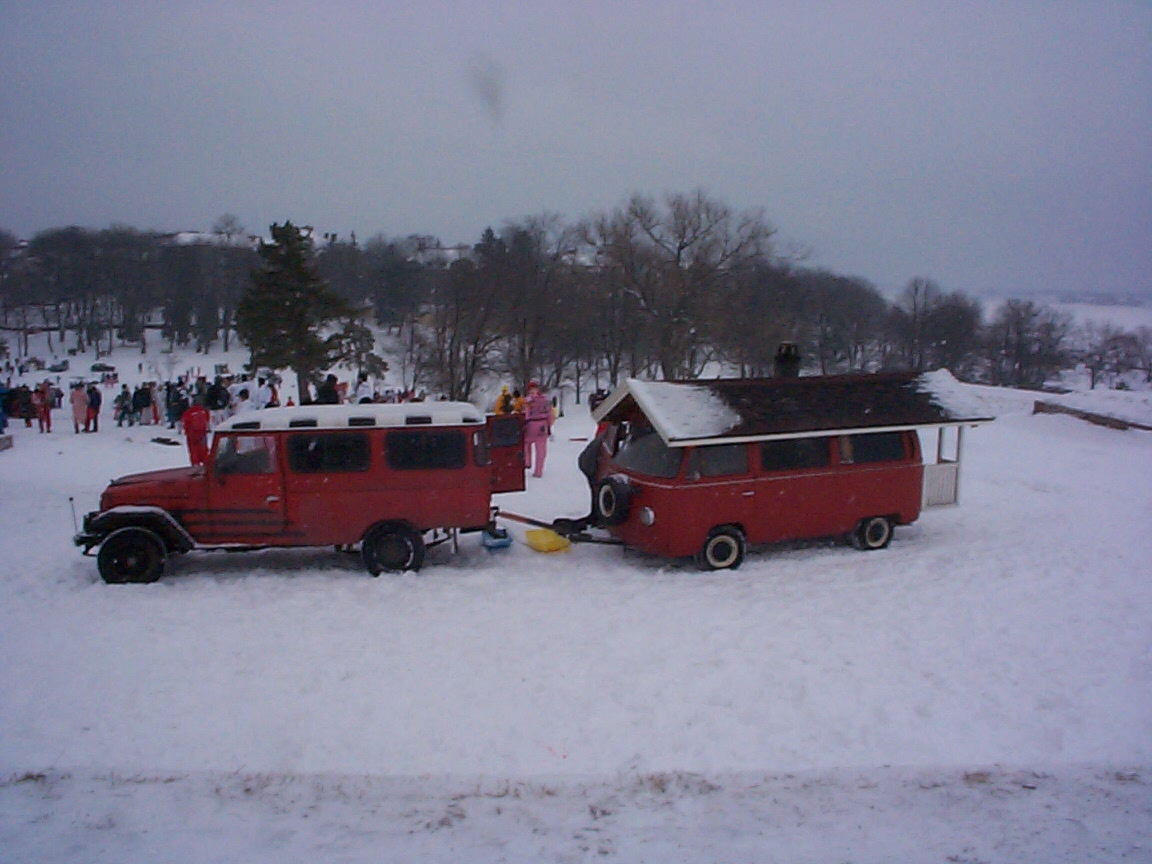
In Finland swimsuits, towels, or any other garments are rarely worn in the sauna. Families often go to the sauna together, which is not considered eccentric since family saunas are an old tradition. In these private saunas swimsuits or towels are never worn. In public saunas it is more common that men and women go to the sauna separately, although people of both sexes may sometimes bathe together, for example in student clubs. Still, saunas are not associated with sex and sexuality. Quite the contrary, historically saunas have been the most sacred places after the church, and most houses which could afford to build a sauna had one. In older times women also used to give birth in the sauna because it was a warm and sterile environment. Children were occasionally born in saunas still in the beginning of the 20th century. Ancient Finns even believed saunas were inhabited by spirits.
The lighting in a sauna is dim, and some Finns prefer to sit in the sauna in silence, relaxing. The temperature is usually between 80 °C (176 °F) and 110 °C (230 °F). Sometimes people make a vasta (or vihta); they tie together small fresh birch branches (with leaves on) and swat themselves and their fellow sauna bathers with it. One can even buy vihtas from a shop and store them into the freezer for later (winter) use. Using a vasta improves blood circulation, and its birch odour is considered pleasing.
Traditional finnish sauna ends to dip in a cool lake or 'avanto' (a hole made in the ice in wintertime) or rolling in the snow. Idea is to cool out after sauna (this must be done carefully, to avoid jeopardy of blackout). Cool-off time can end the sauna experience or it can be followed by another round or two. After showering, it is convention to have a beverage, most commonly a beer or non-alcoholic drink, or traditionally a shot of Koskenkorva (vodka-like traditional finnish spirit).
Currently there is more Saunas than person cars in Finland.
As the home of the sauna,Finnish sauna culture is well established, there are built-in-saunas in almost every house in Finland. Although cultures in all corners of the world have imported and adapted the sauna, many of the traditional customs have not survived the journey. Today, public perception of saunas and sauna customs vary hugely from country to country. In many countries sauna going is a recent fashion and attitudes towards saunas are changing, while in others traditions have survived over generations.
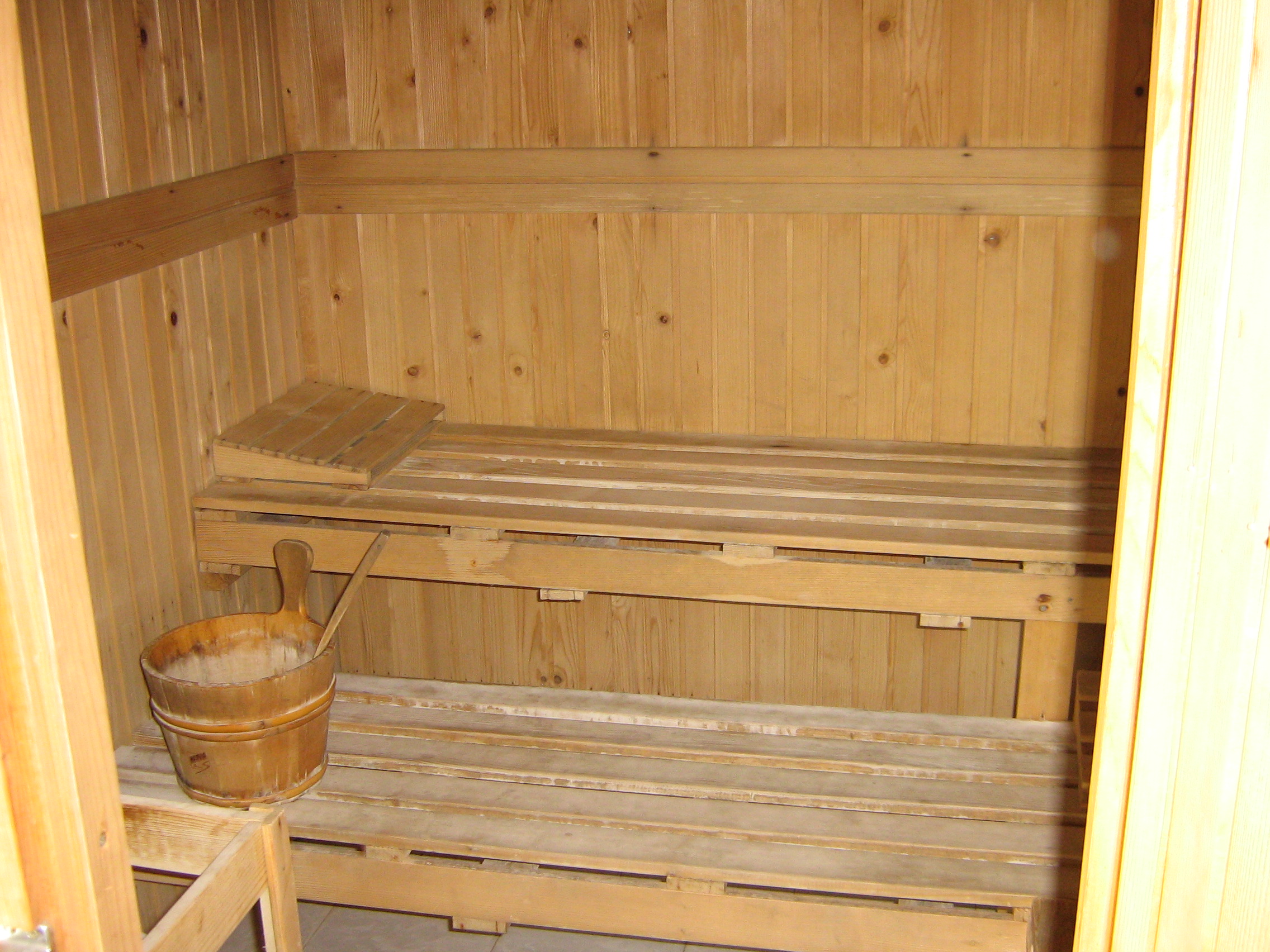
Sauna in Pancevo, Serbia
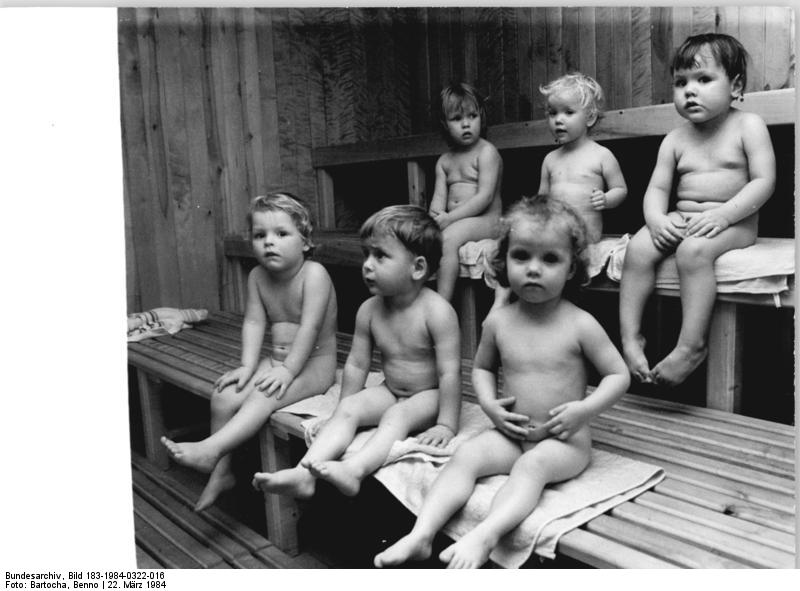
Children in sauna in Germany
Electric stove sauna - Nowadays the most common sauna type. The stones are heated up and kept on temperature using electric heating elements. There is thermostat and a timer (eight hour maximum continuous heating time) on the stove. This type of heating is used in urban saunas.
The second type of sauna is the normal Finnish dry sauna one can find in any gym throughout the world or a hotel. It could be in the locker room or mixed (i.e. male and female together). Attitudes towards nudity are very liberal and people are less self-conscious about their nude bodies.
A steam sauna can take 30 minutes to heat up when first started. Some users prefer taking a warm shower beforehand to speed up perspiration in the sauna. When in the sauna users often sit on a towel for hygiene and put a towel over the head if the face feels too hot but the body feels comfortable. In Russia, a felt "banya hat" may be worn to shield the head from the heat; this allows the wearer to increase the heat on the rest of the body.
Most adjustment of temperature in a sauna comes from,
* amount of water thrown on the heater, this increases humidity, so that sauna bathers perspire more copiously.
* length of stay in the sauna
* positioning when in the sauna
It is cooler on the lower benches, and away from the heater elements, as the heat rises it will be hotter higher up. Provided the sauna is not crowded, lying on a bench is considered preferable as it gives more even temperature over the body. Users increase duration and the heat gradually over time as they adapt to sauna.
When pouring water onto the heater, it will cool down the heater, but carry more heat into the air via advection, making the sauna warmer.
Perspiration is a sign of autonomic responses trying to cool the body. Users are advised to leave the sauna if the heat becomes unbearable, or if they feel faint or ill. Some saunas have a thermostat to adjust temperature, but management and other users expect to be consulted before changes are made. The sauna heater and rocks are very hot - one must stay well clear to avoid injury, particularly when water is poured on the sauna rocks, which creates an immediate blast of steam. Combustibles on or near the heater have been known to result in fire. Wet floors can be slippery. Contact lenses dry out in the heat. Jewellery or anything metallic, including glasses, will get hot in the sauna and can cause discomfort or burning.
Temperature on different parts of the body can be adjusted by shielding from the steam radiator with a towel. Shielding the face with a towel has been found to reduce the perception of heat. It is advised, especially for women to put an additional towel or special cap on hair to avoid their dryness. Few people can sit directly in front of the heater without feeling too hot from radiant heat, but their overall body temperature may be insufficient. As the person’s body is often the coolest object in a sauna room, steam will condense into water on the skin; this can be confused with perspiration.
In an infrared dry sauna, the heaters produce infrared rays that penetrate the skin layers and heat more deeply, It is the user that heats up not so much the room, so it will be cooler. For safety reasons water is not placed on these types of heaters.
Cooling down is part of the sauna cycle and is as important as the heating. Among users it is considered good practice to take a few moments after exiting a sauna before entering a cold plunge, and to enter a plunge pool by stepping into it gradually, rather than immediately immersing fully. Until used to having a full cold shower, warm ones are used gradually make it colder so that the shock is not so great. After a shower, feeling cold or shivering indicates it is enough, the shiver is a sign of the autonomic responses, trying to warm the body. This is considered a signal for the sauna again. If however illness is felt later or during that day, a less hot sauna and warmer, longer cool down is tried then the next day. In summer, any after effects like headache or nausea can come from insufficient cool down after the sauna, or from dehydration, failure to drink enough fluids. Sleep disturbances can also occur if not cooled down properly, even though not feeling hot, the heat in the core of the body may disrupt sleep as the body tries to cool at night. In summer, a session is often started with a cold shower.
Therapeutic sauna has been shown to aid adaptation, reduce stress hormones, lower blood pressure and improve cardiovascular conditions.
Saunas can be dangerous due to the risk of heat prostration or the even more serious hyperthermia. Children and older persons who have heart disease or seizure disorders or those who use alcohol or cocaine are especially vulnerable.
Prolonged stay in a sauna may lead to the loss of electrolytes from the body, the same as after rigorous exercise. Risks of dehydration leading to heat stroke in more sensitive individuals can occur and may be reduced by regular sipping of water or isotonic drinks, but not alcohol, during the sauna. Sauna bathing and heavy drinking of alcoholic beverages, and also sauna bathing during alcohol withdrawal (hangover) phase can undoubtedly create real health risks.
Many of the sauna therapeutic trials used a regular schedule of at least 5 days a week and often daily for one to three months, then several times a week for extended periods.
In some countries the local gymnasium is usually the closest and most convenient and some pool, major sport, or even resort complexes also contain a sauna. Therapeutic Sauna is often carried out in conjunction with physiotherapy or hydrotherapy, gentle exercises within the capability of the person without exacerbating symptoms.
Contraindications to sauna include unstable angina pectoris, recent myocardial infarction and severe aortic stenosis. Sauna is safe, however, for most people with stable coronary heart disease. It is not harmful to the aged when used in moderation, is safe even for young infants over 3 months if limited to short (< 3 minutes) sessions, and does not affect wound healing. Sauna use may reduce the incidence of the common cold, and temporarily relieve the symptoms. It increases performance in endurance sport, increases plasma volume and red cell volume in athletes, decreased systolic blood pressure, significantly improved exercise tolerance, increased peak respiratory oxygen uptake, and enhanced anaerobic threshold in chronic conditions.
Sauna plus multidisciplinary treatment may reduce chronic pain more effectively than multidisciplinary treatment alone. Sauna reduces chronic pain more effectively than cognitive behaviour therapy. It is indicated for rheumatic pain (with cold shower) but not for neuropathic pain. It is effective for appetite loss and mild depression. Indicated in reducing symptoms in Chronic Fatigue Syndrome and rheumatoid arthritis and indicated for anorexia nervosa. Sauna improves function in conditions such as congestive heart failure, and high blood pressure, improves vasodilation, improves heart arrhythmia, and reduces heart rate on exercise. Sauna has been proposed for treatment of other conditions such as glaucoma, Sjorgen syndrome, fibromyalgia, obstructive lung disease, recuperation after childbirth, and also for lifestyle related diseases of diabetes, arteriosclerosis, obesity, hypertension, hyperlipidemia, atherosclerosis and smoking induced symptoms.
Sauna has also been found to reduce levels of stress hormones adrenalin and noradrenalin and to increase levels of beta-endorphin. However it also causes a substantial rise in the stress hormones ACTH (adrenocorticotropic hormone), and cortisol due to hyper thermic stress on the body. Cortisol remains high even after 30 minutes of rest. Sauna also found to reduce prostaglandin F2alpha and protect against oxidative stress. It enhances activation of monocytes to bacteria and endotoxins.
In addition a sauna followed by a cold shower has been shown to reduce pain in rheumatoid arthritis where pain is mediated by sensitized c-fibre sympathetics. Regular saunas have also been found to improve microcirculation and reduce vasoconstriction and hypertension. Many symptoms of chronic illnesses may be due to vasoconstriction effects (e.g. cold sensitivity, physical pain, and even mood states); and sauna improves microcirculation and blood supply to constricted areas.
Research has also shown that adaptation to cold through short term cold stimulus, as in cold swimming, immersion (or showers) has the added benefit of improving the body's anti oxidant capabilities, with increases in glutathione and reduction of uric acid, which may mean better handling of the stresses of illness. Those that are shown to involve reduced glutathione or increased glutathione use, include; cardiovascular conditions, pulmonary diseases, diabetes, inflammatory bowel diseases, cancer, osteoporosis, aging, and after pesticide exposure. Conditions involving oxidative stress include neurodegenerative diseases, CFS, bone fracture and others. Conditions in which increased uric acid may be a risk factor include, gout, metabolic disease and vascular diseases.
A reported study from the Thrombosis Institute in London into the effects of the cold bathing found that volunteers that followed a disciplined daily regime had increased immune white blood cells and the level of the body's natural blood thinning enzymes substantially increased, improving micro circulation. It also stimulated the production of hormones such as testosterone in men, and boosted women's production of estrogen. Cold water immersion raises thresholds of pain tolerance, and aids adaptation to cold, reduces muscle spasm, can influence the frequency of respiratory infections and improve subjective well-being. It may cause an immunological modulation in terms of the Th1-type pattern, which is a pro inflammatory cytokine profile. It is involved in diseases such as arthritis, inflammatory myopathies, inflammatory bowel disease, psoriasis, CFS, fibromyalgia, chronic pain, fatigue conditions, auto-immune disease and other inflammatory conditions. Cold-water adaptation reduced total cholesterol and LDL cholesterol, lowered plasma viscosity and blood pressure rate product. Cold water immersion reduces recovery time in athletes, enhances repeat performance and reduces exercise induced muscle damage.
Cold-water exposure challenges both the neuro-endocrine and the immune systems, reduces stress hormones and attenuates their response. Increases ADH and cortisol and increases immunomodulatory cytokines. Cold water exposure and adaptation can modify the sensory functions of hypothalamic thermoregulatory centres to lower heat loss and produce less heat during cold exposure and have immunostimulating effects. The thermogenic action of adrenaline in cold exposure produces heat and may reduce this stress hormone. An important effect is the ability of sauna to use up excess sympathetic nerve tone in both the central and peripheral nervous systems and just as importantly use up excess levels of local tissue hormones involved in feedback loops to the hypothalamus, thus aiding recovery in chronic illness.
Source: wikipedia